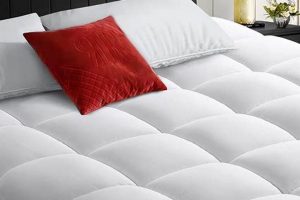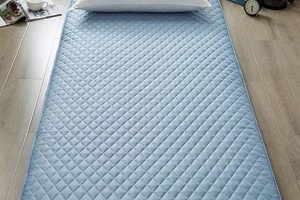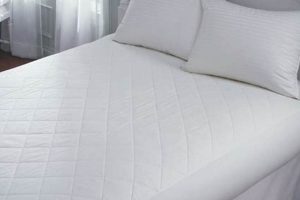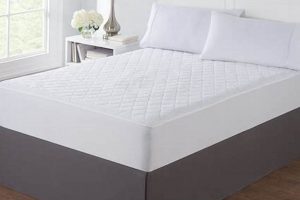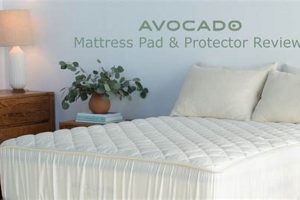This type of mattress topper, characterized by a surface resembling an egg carton, is designed to enhance comfort and support. The convoluted design creates peaks and valleys that distribute weight and promote airflow. A common application is improving the sleeping surface on an existing mattress.
These toppers offer several advantages, including pressure relief, particularly for individuals experiencing joint pain or pressure sores. The increased airflow contributes to temperature regulation, helping to keep sleepers cool. Historically, this design gained popularity due to its affordability and effectiveness in healthcare settings, particularly in preventing bedsores for bedridden patients.
The following sections will delve into the specific materials used in manufacturing this product, examine the variety of available sizes and thicknesses, and discuss the practical considerations involved in selecting and maintaining such a topper.
Selecting and Using a Convoluted Foam Mattress Topper
The selection and use of a convoluted foam mattress topper require careful consideration to ensure optimal comfort and longevity. These tips offer guidance for informed decision-making and effective maintenance.
Tip 1: Density Matters: Higher density foam offers greater support and durability. Consider the density when choosing a topper, especially for individuals requiring significant pressure relief.
Tip 2: Thickness Considerations: Topper thickness influences its impact on mattress firmness. Thicker toppers provide more cushioning, while thinner options offer subtle adjustments.
Tip 3: Material Composition: Options include polyurethane foam, memory foam, and latex. Each material possesses distinct characteristics related to breathability, support, and temperature regulation. Assess individual needs to determine the appropriate material.
Tip 4: Proper Support: A deteriorated mattress will negate the benefits of any topper. Ensure the underlying mattress provides adequate support prior to adding a topper.
Tip 5: Cover Protection: Utilizing a mattress protector over the topper shields against spills, stains, and dust mites, extending the topper’s lifespan and promoting hygiene.
Tip 6: Regular Rotation: Rotating the topper periodically, typically every few months, ensures even wear and prevents indentations from forming in high-pressure areas.
Tip 7: Cleaning Protocol: Follow manufacturer cleaning instructions. Spot cleaning is often preferable to washing the entire topper, as excessive moisture can damage the foam.
By considering these factors, consumers can maximize the benefits of a convoluted foam mattress topper, achieving improved sleep quality and extending the life of their mattress.
The concluding section will summarize the key features and benefits of this type of mattress topper and offer final recommendations.
1. Pressure Distribution
The primary function of a convoluted foam mattress topper resides in its capacity to redistribute pressure. The alternating peaks and valleys of the design generate varied surface contact points. This irregular pattern mitigates concentrated pressure on specific body regions, notably the shoulders, hips, and knees. Consequently, this reduced pressure contributes to minimizing discomfort and potential pain associated with prolonged static positioning during sleep.
The effect of this distribution mechanism is particularly relevant for individuals with pre-existing conditions, such as arthritis or fibromyalgia, where pressure sensitivity is heightened. The design’s alteration of the contact area translates into a tangible reduction in discomfort. For example, a person experiencing hip pain when lying on a conventional mattress may find relief through the pressure-redistributing properties of the topper. The topper’s surface conforms to the body’s contours, creating a more uniform distribution of weight and thus lessening localized stress.
In summation, the effectiveness of a convoluted foam mattress topper is intrinsically linked to its ability to facilitate pressure distribution. The design’s core attribute, its uneven surface, directly influences its capacity to improve sleep comfort and alleviate pressure-related pain. This understanding underscores the practical importance of selecting a topper that exhibits a degree of firmness and contouring suited to individual needs and pre-existing conditions.
2. Air Circulation
Air circulation is a key determinant of sleep comfort, especially in relation to mattress toppers. The design of the topper significantly impacts its capacity to facilitate airflow and regulate temperature. Convoluted foam mattress toppers are specifically engineered to promote ventilation, setting them apart from solid foam alternatives.
- Convoluted Surface Design
The “egg crate” configuration inherently creates channels and spaces between the foam peaks. These channels function as conduits for air movement, allowing heat to dissipate away from the sleeper’s body. This feature is particularly beneficial for individuals prone to overheating during sleep.
- Material Permeability
The type of foam used, such as open-cell memory foam or polyurethane, influences air permeability. Open-cell structures provide pathways for air to flow through the material, enhancing ventilation compared to closed-cell foams. The choice of material impacts the topper’s overall breathability.
- Moisture Management
Effective air circulation contributes to moisture management within the sleeping environment. By allowing air to circulate, moisture buildup from perspiration is reduced. This prevents the topper from becoming damp and creating an environment conducive to microbial growth, thereby promoting hygiene.
- Temperature Regulation
The combined effect of surface design and material permeability results in improved temperature regulation. By facilitating heat dissipation and moisture evaporation, the topper helps maintain a consistent and comfortable sleep temperature. This prevents overheating and enhances overall sleep quality.
The interplay between these facets highlights the importance of air circulation in the context of convoluted foam mattress toppers. The design’s inherent ventilation properties, combined with material selection, determine the topper’s ability to regulate temperature, manage moisture, and ultimately, enhance sleep comfort. The design significantly improves circulation and overall sleep quality, even more compared to other toppers.
3. Cost-Effectiveness
The designation of “egg crate mattress pad” as a cost-effective sleep solution stems from several factors. Production utilizes relatively inexpensive materials, typically polyurethane foam, contributing to a lower initial purchase price compared to alternatives such as memory foam or latex toppers. The manufacturing process is straightforward, reducing production costs and enabling affordability for a broader consumer base.
The practical significance of this cost-effectiveness extends beyond the initial purchase. By prolonging the lifespan of an existing mattress, these toppers postpone the expense of complete mattress replacement. For instance, an aging mattress experiencing minor sagging can be revitalized with a topper, delaying the substantial investment of a new mattress purchase. Furthermore, the toppers’ potential to alleviate pressure points and improve sleep quality may reduce reliance on pain medication or therapeutic interventions, indirectly contributing to cost savings in healthcare.
While the initial investment is lower, the lifespan and durability of these toppers can vary. Lower-density foam options may degrade more quickly, necessitating more frequent replacements. Despite this potential limitation, the initial cost advantage, coupled with the capacity to extend mattress lifespan and potentially reduce healthcare-related expenses, solidifies the designation of the “egg crate mattress pad” as a cost-effective option for enhancing sleep comfort and support.
4. Size Availability
The range of available sizes for convoluted foam mattress toppers directly influences their practical utility and compatibility with diverse sleep environments. Proper sizing is essential to realizing the intended benefits, such as pressure relief and improved air circulation. A mismatch in dimensions can compromise the topper’s effectiveness and overall comfort.
- Standard Mattress Dimensions
Convoluted foam toppers are typically manufactured to conform to standard mattress dimensions, including Twin, Twin XL, Full, Queen, King, and California King. This standardization ensures compatibility with the majority of bed frames and mattresses in use. Deviations from these standard sizes are less common and may require custom orders.
- Precise Fit and Edge Support
An accurately sized topper extends to the edges of the mattress, providing consistent support and pressure distribution across the entire sleeping surface. Oversized toppers may overhang, creating uneven surfaces and potential hazards. Undersized toppers leave portions of the mattress exposed, diminishing the intended benefits of pressure relief and airflow in those areas.
- Impact on Bedding Fit
The addition of a topper, regardless of its size, may impact the fit of existing bedding. Deeper fitted sheets may be necessary to accommodate the added height of the topper and mattress. Careful consideration of sheet depth is crucial to maintain a secure and comfortable sleeping surface.
- Specialty Sizes and Customization
While standard sizes are prevalent, specialty sizes may be available for non-standard mattresses, such as those found in RVs or antique beds. Customization options allow for tailored dimensions to ensure a precise fit. However, custom orders typically incur higher costs and longer lead times.
The correlation between size availability and the effectiveness of an “egg crate mattress pad” underscores the importance of precise measurement and careful selection. Ensuring the topper dimensions align with the mattress dimensions optimizes support, pressure relief, and overall sleep comfort. A well-fitted topper maximizes the intended benefits and contributes to a more restful sleep experience.
5. Material Options
The performance and longevity of a convoluted foam mattress topper are inextricably linked to the material composition. The choice of material directly affects factors such as support, pressure relief, temperature regulation, and durability. Consequently, understanding the properties of different materials is crucial for selecting a topper that aligns with individual needs and preferences. The primary materials employed in manufacturing these toppers include polyurethane foam, memory foam (viscoelastic polyurethane foam), and latex foam, each exhibiting distinct characteristics.
Polyurethane foam represents the most common and often the most economical option. Its density and firmness influence the level of support provided. Higher-density polyurethane foams offer greater resistance to compression and improved durability, while lower-density options are more susceptible to degradation over time. Memory foam, conversely, conforms closely to the body’s contours, distributing weight evenly and minimizing pressure points. This characteristic is particularly beneficial for individuals seeking enhanced pressure relief. Latex foam offers a balance of support and responsiveness, possessing inherent elasticity and breathability. It also tends to be more durable and resistant to microbial growth compared to polyurethane foams. For instance, a consumer seeking targeted pressure relief may prioritize a memory foam topper, while an individual prioritizing durability and breathability might opt for a latex topper.
In summary, the selection of the material fundamentally defines the characteristics and performance of a convoluted foam mattress topper. Polyurethane foam, memory foam, and latex foam each offer a unique blend of support, pressure relief, durability, and temperature regulation. Careful consideration of these material properties is essential for making an informed purchasing decision and maximizing the benefits of this type of mattress topper. Ultimately, the optimal choice hinges on individual needs, preferences, and budgetary considerations.
6. Support Enhancement
The capacity of a convoluted foam mattress topper to enhance support constitutes a primary consideration in its selection and application. While not designed to correct severe mattress deficiencies, these toppers can augment existing support levels and improve overall sleep posture.
- Addressing Minor Sagging
One facet of support enhancement involves mitigating minor sagging in aging mattresses. The topper’s addition provides a more uniform surface, compensating for slight indentations and preventing the sleeper from rolling into the center of the bed. This is particularly relevant for mattresses that have experienced wear and tear over time, but are not yet in need of complete replacement. This can increase the overall value of the pad.
- Augmenting Firmness
Convoluted foam can offer a subtle increase in firmness. This is beneficial for individuals who find their current mattress too soft and desire a more supportive sleeping surface. The topper provides an additional layer of resistance, preventing excessive sinking and promoting spinal alignment. The effect is not equivalent to a completely firm mattress, but represents a compromise between softness and support.
- Distributing Weight Evenly
The design of the topper contributes to distributing weight more evenly across the mattress surface. This reduces pressure on specific areas, such as the hips and shoulders, and promotes better circulation. Even weight distribution also minimizes the formation of pressure points, contributing to enhanced comfort and reduced pain during sleep.
- Providing a More Stable Surface
The topper can contribute a more stable surface, especially on mattresses with uneven surfaces or those that transfer motion excessively. By dampening movement, the topper reduces disturbances caused by a restless partner, leading to improved sleep quality for both individuals. This stabilizing effect enhances the overall functionality of the sleep environment.
These support enhancement aspects collectively underscore the practical value of an “egg crate mattress pad.” While the degree of support provided is contingent upon the topper’s density, thickness, and the underlying condition of the mattress, the topper serves as a supplementary element to improve sleep posture, reduce pressure points, and augment overall comfort. The topper improves comfort in an efficient manner.
Frequently Asked Questions Regarding Convoluted Foam Mattress Toppers
This section addresses common inquiries and misconceptions concerning convoluted foam mattress toppers, providing factual information to assist in informed decision-making.
Question 1: What is the typical lifespan of a convoluted foam mattress topper?
The lifespan varies considerably based on the density of the foam, frequency of use, and care provided. Lower-density toppers may exhibit degradation within one to two years, while higher-density options can last three to five years or more. Regular rotation and the use of a mattress protector can extend the lifespan.
Question 2: Does a convoluted foam mattress topper eliminate the need for a new mattress?
A topper is designed to enhance the comfort of an existing mattress, not to replace a significantly deteriorated one. While it can improve support and pressure relief, it cannot compensate for severe sagging, broken springs, or other major mattress defects. A severely damaged mattress necessitates replacement.
Question 3: Are convoluted foam mattress toppers suitable for individuals with allergies?
Some individuals may experience allergic reactions to certain foam materials. Options made from hypoallergenic materials, such as latex or those treated with antimicrobial agents, are recommended for allergy sufferers. Regular cleaning and the use of a mattress protector can also minimize allergen exposure.
Question 4: How does topper thickness affect its performance?
Topper thickness influences the degree of cushioning and support provided. Thicker toppers offer greater pressure relief and contouring, while thinner options provide a more subtle adjustment to mattress firmness. The optimal thickness depends on individual preferences and the condition of the underlying mattress.
Question 5: What is the recommended method for cleaning a convoluted foam mattress topper?
Spot cleaning with a mild detergent and water is generally recommended. Avoid immersing the topper in water, as excessive moisture can damage the foam. Allow the topper to air dry completely before use. Adherence to manufacturer instructions is essential.
Question 6: Does a convoluted foam mattress topper contribute to overheating during sleep?
While some foam materials can retain heat, the convoluted design promotes air circulation, which helps to dissipate heat and regulate temperature. Open-cell foam options are generally more breathable than closed-cell foams. Selection of appropriate materials and the use of breathable bedding can minimize the risk of overheating.
In summation, convoluted foam mattress toppers offer a cost-effective means of enhancing sleep comfort. However, careful consideration of material, density, thickness, and maintenance requirements is crucial to realizing their intended benefits.
The following section will provide concluding remarks summarizing the key attributes and applications of convoluted foam mattress toppers.
Conclusion
The preceding analysis has explored the attributes and applications of the “egg crate mattress pad.” This type of topper, characterized by its convoluted surface, offers a cost-effective means of enhancing mattress comfort and providing supplemental support. Key benefits include improved pressure distribution, enhanced air circulation, and a range of material options to suit individual preferences. Selection criteria should include density, thickness, and material composition to optimize performance and longevity. Proper maintenance, including regular rotation and appropriate cleaning, is essential for maximizing the lifespan of the topper.
The “egg crate mattress pad” represents a pragmatic solution for addressing minor mattress deficiencies and improving sleep quality. Consumers should carefully evaluate their individual needs and existing mattress conditions to determine the suitability of this product. While not a replacement for a significantly damaged mattress, a well-chosen and properly maintained topper can offer tangible improvements in comfort and support, thereby contributing to a more restful and restorative sleep experience.


![Top Rated: Best Mattress Pad for Back Pain Relief [Guide] Organic & Natural Mattress Buyer’s Guide: Non-Toxic Sleep Solutions Top Rated: Best Mattress Pad for Back Pain Relief [Guide] | Organic & Natural Mattress Buyer’s Guide: Non-Toxic Sleep Solutions](https://mattressworldpa.com/wp-content/uploads/2025/07/th-4688-300x200.jpg)
